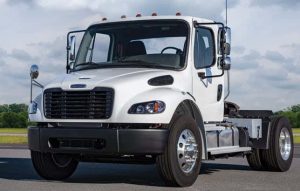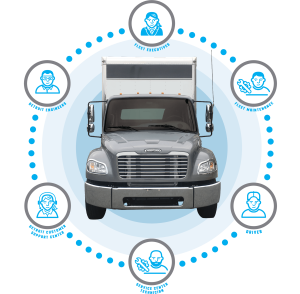Freightliner Trucks -Take Control Of Your Total Cost Of Ownership
 Business owners have long since learned that getting a “good deal” on a purchase price doesn’t always mean you’re getting a good deal in the long run. That’s why Freightliner Trucks and many other OEMs now talk about total cost of ownership, or TCO.
Business owners have long since learned that getting a “good deal” on a purchase price doesn’t always mean you’re getting a good deal in the long run. That’s why Freightliner Trucks and many other OEMs now talk about total cost of ownership, or TCO.
What really counts is how long your truck lasts. And how much you spend on operations, maintenance, repairs and other things associated with owning and using that vehicle, during the entire time you own it. Only by doing the math, across all those years, can you know your true total cost of ownership.
Your goal, of course, is to reduce that TCO number as much as you can. Cost-per-mile is a good indicator of how cost-effectively your truck is performing, especially if you calculate it as an annualized figure rather than monthly. But CPM is just one of the factors that go into determining total cost of ownership.
The newest Freightliner trucks have been specially engineered to address these factors. You can lower TCO if you consciously address each of these areas even if you aren’t quite ready for a new truck.
Fuel efficiency.
Whether you’re an owner-operator or you manage a large fleet, fuel is probably your highest expense (aside from payroll in larger firms), so this is your greatest opportunity to save money. Improving mileage by even one mpg could make a significant difference in your bottom line.
Freightliner Truck’s new Cascadia Evolution incorporates fuel-efficient technologies such as RunSmart Predictive CruiseTM, which integrates GPS and digital mapping to show drivers a three-dimensional view of the road ahead, and ParkSmart TM, a battery-powered heating and cooling system that provides emissions-free cooling and super-efficient heating without having to let your engine idle. Reducing idle time enables you to meet new compliance standards and reduces wear and tear, too.
Ideal RPM.
Every engine has a “favorite” RPM, where it runs most efficiently and performs well. Freightliner reports that the engines they use tend to run optimally at 1250-1350 RPM, but that could vary for other brands. Ideal RPM matters because if you use torque to pull your load rather than relying on raw horsepower, you’ll use less fuel.
Down time.
 If your truck isn’t on the road, it’s not making money. Spending less money on maintenance is important, but so is getting the work done faster. Freightliner trucks now feature fewer parts that are easier to reach, often grouped for even greater service efficiency. Perishable parts, oils and other lubricants last longer.
If your truck isn’t on the road, it’s not making money. Spending less money on maintenance is important, but so is getting the work done faster. Freightliner trucks now feature fewer parts that are easier to reach, often grouped for even greater service efficiency. Perishable parts, oils and other lubricants last longer.
Freightliner has also added DetroitTM Virtual TechnicianTM, new technology that allows you to monitor every detail of yourDetroit truck engine’s performance. You get real-time maintenance alerts, and you can remotely schedule service.
All that means you can schedule preventive maintenance less often, but it’s still critical to stay on schedule. Otherwise, you’re increasing the risk of excessive wear and tear and even on-the-road breakdown. And that adds up to unnecessary expense and costly time in the shop.
Even if you’re able to take advantage of all these new innovations, your best bet is to link up with a top-rated dealer, because they’ll help you stay on top of maintenance scheduling and they’ll have your back when you need parts or repairs at a moment’s notice.
Indirect costs.
Everything we’ve talked about so far is an obvious cost of ownership. But other costs are less apparent. One example is interest you may be paying on late self-employment taxes or unpaid quarterly estimates. It’s tempting to skip those if your cash flow fluctuates, but interest penalties can add up. Pay yourself current and you won’t accrue additional unnecessary fees.
Many companies are now using fleet management software to automatically capture detailed fleet data and calculate financially important information such as mileage and cost per mile. Yes, this software costs money, too, but it can make tracking total cost of ownership much faster and simpler. More accurate, too. It can pay for itself and then keep working to help you lower that all-important TCO.
